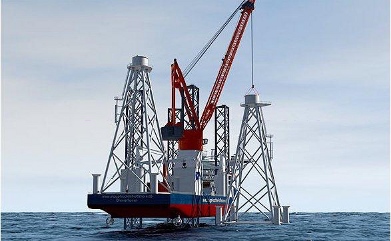Research project
Since 17.03.2011 the Lower Saxony Ministry for Science and Culture has supported the project SOOP with funding from the European Regional Development Fund (ERDF) equivalent to € 2.5m over a period of 3.5 years. Within the research project, the cooperation of OFFIS (Oldenburg Research and Development Institute for Information Technology Tools and Systems), Carl von Ossietzky University Oldenburg (Department of Informatics), University of Applied Sciences Emden/Leer (Technology Department) and Jade University of Applied Sciences (Faculty of Nautical Science) is supported by a number of maritime, offshore and energy industry business partners, particularly Ems Offshore GmbH, Business Technology Consulting AG, IBM Hannover, ENKO, InnoTec Data GmbH & Co. KG, Rostock University and others.
The objective of the research is the development of tools and procedures for planning, risk analysis, simulation, training and execution of offshore operations using the example of wind energy farm installation and maintenance works by means of self-organised sensor networks and risk analysis tools off the German coast.
The task of Jade University of Applied Sciences within the project amounts to approximately € 500k and consists of the generation of example scenarios for all phases of the project. The scenarios are used to model, test and validate the developments of the cooperating partners on the simulators of the Nautical Faculty, in model basins and on full scale sea trials. The findings are complemented by reference studies on ship motions in seaways and the description of maritime logistics chains for the installation and maintenance of offshore wind energy farms.
Motivation
Working offshore is always coupled with risks to human health and the risk of machine failure. Wind, waves, moisture, fouling and insolation always threaten equipment and installations. Offshore operations, such as installation or maintenance and especially urgent repairs are complicated and usually performed under difficult circumstances. Many influencing factors create a continually changing working environment for the maintenance personnel. To reduce the risks, it is imperative to accurately predict the environment as well as the response of the processes to it. Ultimately, several vessels with heavy machinery combined with personnel performing assembly operations need to be able to operate safely in a broad range of environmental conditions.
Description of scenarios
Mastering heavy lift technology for offshore operations can become a large contribution to strengthening the European shipbuilding industry [1], which the newly founded International Council of Heavy Lift and Project Cargo Carriers (Heavy Lift Club, HLC) emphasises. The major difficulty of this technology lies mainly in the unpredictable mechanical load on crane components due to motions in variable sea states. This is the reason why Jack-Up technology with four extendable stilts is used off the German coast. Efforts are made to reduce the lateral load on the stilts that results from the seaway [2].
Within the project the following key scenarios are defined:
Loading and installation operation by means of one or more cranes
The complexity of a loading operation is reduced by the option of anchoring the vessel on the seabed. Loading, transfer and installation of heavy cargo in offshore conditions is modelled, simulated and monitored. During simulation, one or two cranes can be used. Crane and machinery are modelled by a simple kinematic chain. The focus lies on the description of the tasks and the behaviour of the personnel involved. The scenario is complemented by considering the influences of wind to better integrate sensor networks in the scenario.
The research carried out on the heavy lift simulator in Elsfleth and the findings can then be projected to reality.

Transfer operation
Transfer of personnel to an offshore wind power station is strongly influenced by environmental conditions. This type of offshore scenario occurs regularly (e.g. transfer of pilots) but is extremely dangerous because leeward mooring is not always possible, as can for example be seen on the failed rescue attempts on a wind power station (WEA) on Alpha Ventus last winter.
The purpose of the first scenario lies mainly in the development of behaviour and task simulation while the second scenario is focused on testing and usage of the sensor networks. Both are elemental tasks of more complex scenarios that occur regularly during installation, maintenance and renewal of offshore wind energy farms. The enormous range of parameters and process data needs to be managed. A more concrete test scenario depends mainly on the experience gained in the field by project partners during the first project phase.
Sources
[1] http://www.offshore-technology.com/features/feature65273
[2] www.marin.nl/web/Ships-Structures/Offshore-structures/Jackup.htm
Further Information

